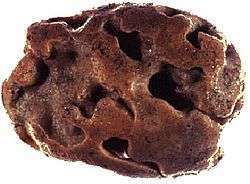Halichondria
| Halichondria | |
|---|---|
 | |
| Halichondria panicea | |
| Scientific classification | |
| Kingdom: | Animalia |
| Phylum: | Porifera |
| Class: | Demospongiae |
| Order: | Halichondrida |
| Family: | Halichondriidae |
| Genus: | Halichondria |
| Species | |
|
see text | |
Halichondria is a genus of marine demosponges belonging to the family Halichondriidae.[1][2] These are massive, amorphous sponges with clearly separated inner and outer skeletons consisting of bundles of spicules arranged in a seemingly random pattern.
This genus of sponges became important through the discovery of cell division limiting properties of the extract Halichondrin B, which inhibits cell mitosis. The drug Eribulin, a related compound and an inhibitor of microtubule function, has become an important chemotherapy treatment for certain types of cancer.[3][4][5][6][7]
Species
|
|
References
- 1 2 van Soest, R. (2014). Van Soest RW, Boury-Esnault N, Hooper JN, Rützler K, de Voogd NJ, de Glasby BA, Hajdu E, Pisera AB, Manconi R, Schoenberg C, Janussen D, Tabachnick KR, Klautau M, Picton B, Kelly M, Vacelet J, eds. "Halichondria Fleming, 1828". World Porifera database. World Register of Marine Species. Retrieved 2014-04-30.
- ↑ A systematic revision of the central West Atlantic: Halichondrida (Demospongiae, Porifera). Part III: Description of valid species
- ↑ Towle, Murray J.; Salvato, Kathleen A.; Budrow, Jacqueline; Wels, Bruce F.; Kuznetsov, Galina; Aalfs, Kimberley K.; Welsh, Susan; Zheng, Wanjun; Seletsk, Boris M.; Palme, Monica H.; Habgood, Gregory J.; Singer, Lori A.; Dipietro, Lucian V.; Wang, Yuan; Chen, Jack J.; Quincy, David A.; Davis, Ashley; Yoshimatsu, Kentaro; Kishi, Yoshito; Yu, Melvin J.; Littlefield, Bruce A. (2 February 2001). "In vitro and in vivo anticancer activities of synthetic macrocyclic ketone analogues of halichondrin B". Cancer Research. 61 (3): 1013–1021. PMID 11221827.
- ↑ Yu, Melvin J.; Kishi, Yoshito; Littlefield, Bruce A. (2005). "Discovery of E7389, a fully synthetic macrocyclic ketone analogue of halichondrin B". In Newman, David J.; Kingston, David G.I.; Cragg, Gordon M. Anticancer agents from natural products. Washington, DC: Taylor & Francis. ISBN 978-0-8493-1863-4. OCLC 57169963.
- ↑ Hirata, Yoshimasa; Uemura, Daisuke (January 1986). "Halichondrins - antitumor polyether macrolides from a marine sponge" (PDF). Pure and Applied Chemistry. 58 (5): 701–710. doi:10.1351/pac198658050701.
- ↑ Bai, Ruoli L.; Paull, Kenneth D.; Herald, Cherry L.; Malspeis, Louis; Pettit, George R.; Hamel, Ernest (25 August 1991). "Halichondrin B and Homohalichondrin B, Marine Natural Products Binding in the Vinca Domain of Tubulin. Discovery of tubulin-based mechanism of action by analysis of differential cytotoxicity data". The Journal of Biological Chemistry. 266 (24): 15882–15889. PMID 1874739.
- ↑ Jordan, M.A.; Kamath, K.; Manna, T.; Okouneva, T.; Miller, H.P.; Davis, C.; Littlefield, B.A.; Wilson, L. (July 2005). "The primary antimitotic mechanism of action of the synthetic halichondrin E7389 is suppression of microtubule growth". Molecular Cancer Therapeutics. 4 (7): 1086–1095. doi:10.1158/1535-7163.MCT-04-0345. PMID 16020666.
This article is issued from
Wikipedia.
The text is licensed under Creative Commons - Attribution - Sharealike.
Additional terms may apply for the media files.